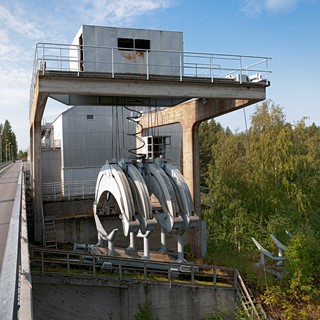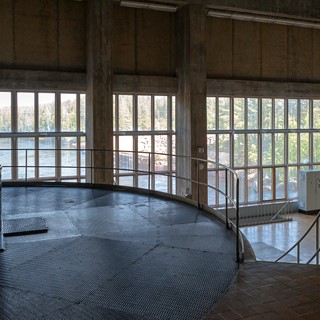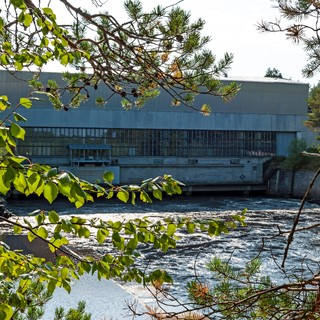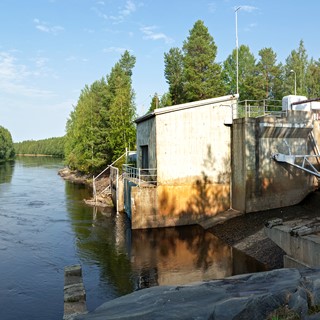Utanen & Ala-Utos
Utanen hydropower plant, designd by Aarne Ervi, was built between 1953 and 1957 in Utajärvi municipality. The power plant´s special feature is its tailrace, over 11 km long. The channel was the largest earthmoving undertaking in Finnish history. A small power plant called Ala-Utos was also built on the embankment of the tailrace.
History
Preparatory works for Utanen started in late 1952 by building temporary housing and service buildings. The actual residential area was built later in the 50s. Construction of the power plant started the following year. The north side of the dam was finished at the end of 1953 and the southern side soon after this. The sets of machineries were ordered from two Finnish companies, turbines from Tampella and generators from Strömberg. [1]
Earthworks for the tailrace started in the spring of 1954. Excavations for the canal were extensive. Almost 4 million cubic meters of rock had to be removed. Nine diggers, more than ten bulldozers and 30 heavy dump trucks were assigned to the task. It turned out to be the largest earthmoving job in Finnish history[2]. People of Utajärvi had to stay inside during the rock blasting and Oulujoki Power Company paid them 100 Marks per blast[3]. The power house, designed by Aarne Ervi, has an in-situ concrete frame. Facades were constructed out of precast panels.
In May 1956, water was released to the reservoir. Tailrace was finished at the end of the year and the first set of machinery was connected to the power grid on 19 November 1956. Because of the long tailrace, landscaping went on for decades.[4]
The second set of machinery was connected to the power grid late in 1956 and the third one in the summer of 1957. Electricity production started in fall 1957. Utanen has a maximum capacity of 58 MW, which makes it the third largest power plant on the Oulujoki. After Utanen was finished the main channel of the Oulujoki was completely harnessed to electricity production.[5]
[1] Mauri Kuuskoski, Pekka Salminen, Jouko Vahtola, Paavo Vasala. Vesivoimaa Oulujoesta 50 vuotta: sähkölla eteenpäin. Oulu: Oulujoki Oy, 1991, 42-43
[2] Matti Enbuske. Pohjois-Pohjanmaan ympäristöhistoria. Oulu: Pohjois-Pohjanmaan ELY-keskus ympäristö ja luonnonvarat -vastuualue, 2010, 319
[3] Ibid, 319
[4] Mauri Kuuskoski, Pekka Salminen, Jouko Vahtola, Paavo Vasala. Vesivoimaa Oulujoesta 50 vuotta: sähkölla eteenpäin. Oulu: Oulujoki Oy, 1991, 43-44
[5] Matti Enbuske. Pohjois-Pohjanmaan ympäristöhistoria. Oulu: Pohjois-Pohjanmaan ELY-keskus ympäristö ja luonnonvarat -vastuualue, 2010, 319
Technical information
Owner: Fortum Power and Heat
Built: 1953-1957
Designer: Aarne Ervi, architect
Capacity: 58 MW, head 15.7 m
Power house: In-situ concrete frame, precast panels
Special features: Tailrace is over 11 km long. Original log lift is still in place, a small power plant called Ala-Utos was built on the embankment of the tailrace.
Protection status: Classified as RKY (Nationally significant built cultural environment – RKY 2009: Hydropower plants on the River Oulujoki and Sotkamo Route), Docomomo site[6]
[6] Veli-Pekka Huhmo. Oulujoen vesistön voimalaitosarkkitehtuuria. Oulu: Humanpolis Oy, 2017, 77
Residential area
Utanen has a residential area that consists of rowhouses. It was built in the 1950s.
Ala-Utos
At the same time with Utanen, another, a smaller power plant was also constructed on the side of the tailrace. It was called Ala-Utos. The water that run in the the River Utosjoki to Utajärvi (Lake Utajärvi) was going to be drained through an ungated spillway on the embankment. Builders realised that they could utilize this fall. So, the ungated spillway was replaced with a flood gate. A small power house was built on the side and a logway on the other side. The set of machinery was ready in the fall of 1957 and the power plant started producing power with 0.5 MW capacity.[7]
[7] Mauri Kuuskoski, Pekka Salminen, Jouko Vahtola, Paavo Vasala. Vesivoimaa Oulujoesta 50 vuotta: sähkölla eteenpäin. Oulu: Oulujoki Oy, 1991, 44

Images
All pictures below are part of the power plant's history. All images are copyrighted. You may use the images for personal use but the images may not be used in commercial contexts or printed matter without our permission. Click on the pictures to enlarge them.



